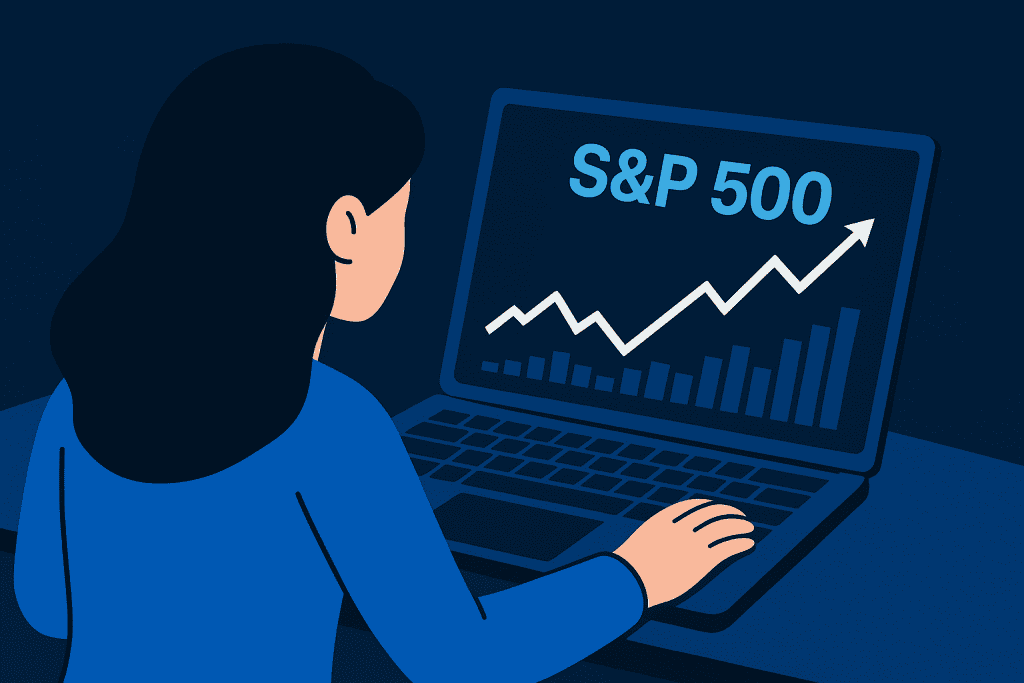
Starting your investing journey can feel like standing at the edge of a pool, unsure of whether to jump in. But just like swimming, once you understand the basics, it gets easier. If you’re here to learn how to invest in S&P 500, you’re on the right track.
The S&P 500 isn’t some complicated financial maze. It’s a collection of the 500 largest companies in the U.S. When you invest in it, you own a piece of big names like Apple, Microsoft, and Amazon. You’re not picking one stock and hoping it skyrockets. You’re spreading your money across an entire market.
This guide will show you everything you need, from the tools to the steps, and even some beginner-friendly tips. If you stick around, you’ll not only learn how to invest but also how to do it wisely and confidently.
Materials or Tools Needed
Before diving into the market, get your essentials ready. These items will help you start your investing journey.
| Item | Purpose |
|---|---|
| Online Brokerage Account | Lets you buy S&P 500 index funds or ETFs |
| Bank Account | Funds your investments |
| Reliable Internet Access | Helps manage your investments easily |
| Government ID | Verifies your identity during sign-up |
| Investment Plan | Guides your strategy and risk level |
Your investment plan should include your goal, risk level, and timeline. That way, you’ll avoid acting on impulse or emotion later.
Step-by-Step Instructions

Now that you’re equipped, it’s time to take action. Follow these simple steps to start investing in the S&P 500 today.
Step 1: Choose a Brokerage
To buy an S&P 500 fund, you need a brokerage account. This acts as your gateway to the stock market. Pick a broker that suits your style. Most beginners prefer user-friendly platforms like:
- Fidelity
- Vanguard
- Charles Schwab
- Robinhood
- M1 Finance
I started with Vanguard because it had a clean layout and no confusing buttons. It helped me focus on learning rather than worrying about what to click next.
Step 2: Fund Your Account
Once you set up your account, the next step is to add money. Link your bank account and decide how much to deposit. You don’t need thousands to start. Even $50 is a good beginning.
Remember when I funded my account with just $100? It felt small, but it gave me the confidence to move forward. The important part is to start.
Step 3: Pick Your S&P 500 Fund
You’ll see a few options that all track the same index. These are the most common and reliable:
- VOO (Vanguard S&P 500 ETF)
- SPY (SPDR S&P 500 ETF Trust)
- FXAIX (Fidelity 500 Index Fund)
Each fund mirrors the same index, but they can differ in fees, trading volume, and minimum investment. Vanguard and Fidelity are often praised for their low fees and long-term focus. Look at the expense ratio, fund performance, and broker compatibility to choose the one that fits your needs. If you’re still not sure, go with one that your brokerage recommends for beginners.
Step 4: Buy Your Shares
Click the “Buy” button. Enter how many shares or how much money you want to invest. Then confirm the order.
If your broker supports fractional shares, you can buy with as little as $1. That’s how I got my first slice of the S&P 500—just five bucks.
Step 5: Set Up Automatic Investments
Consistency is key. Set up recurring investments so your money grows without you thinking about it. Most brokers let you automate weekly or monthly contributions.
I automated $50 a month. It didn’t hurt my wallet, and over time, it built real momentum
Tips and Warnings

Even seasoned investors need reminders. These tips will keep you grounded, while the warnings help you avoid beginner mistakes.
Tips for Success
- Start early: Time grows your money. The earlier you begin, the more your returns compound.
- Stay consistent: Regular investing builds discipline and smooths out market ups and downs.
- Keep it simple: Avoid trying to outsmart the market with short-term trades.
- Reinvest dividends: This boosts your long-term growth.
- Review your strategy yearly: Make sure your goals and risk level still match.
- Avoid comparing with others: Your plan is unique. Focus on your own growth.
Common Mistakes to Avoid
| Mistake | Why to Avoid It |
|---|---|
| Timing the market | You can’t predict highs and lows reliably |
| Panicking during drops | Markets go down sometimes—it’s normal |
| Ignoring fees | Small costs eat into your gains over time |
| Investing without a plan | You risk acting emotionally and losing focus |
Don’t expect overnight success. Investing in the S&P 500 is more like planting a tree than playing a slot machine.
Conclusion
Investing in the S&P 500 is one of the easiest ways to start building wealth. It doesn’t take a lot of money or deep financial knowledge. Once you open a brokerage account, fund it, and choose an S&P 500 index fund, you’re already on your way. The most important part is getting started.
Over time, your investments can grow through the power of compounding. Even small, consistent contributions can lead to significant results. The key is to stay committed and avoid reacting emotionally to market ups and downs.
Keep your focus on the long-term goal. Trust the process, review your progress every now and then, and stay consistent. Your future self will thank you for taking this first step today.
FAQ
How to invest in S&P 500 with little money?
Use a broker that offers fractional shares like Fidelity, M1 Finance, or Robinhood. You can start with just a few dollars.
Is investing in the S&P 500 safe for beginners?
Yes. It spreads your money across 500 top companies, making it a low-risk, long-term option.
Can I invest in the S&P 500 monthly?
Yes. Most platforms let you automate monthly investments, helping you stay consistent and grow steadily.
Resources
- Martinos & Co. How to Invest in the S&P 500: Beginners Guide
- Bear Savings. How to Invest in the S&P 500
- Moomoo. How to Invest in the S&P 500
- USA Today. Investing in the S&P 500
- District Capital Management. Guide to Investing in the S&P 500
